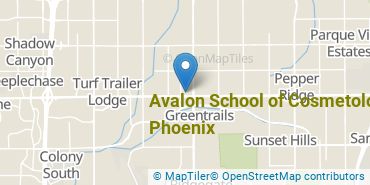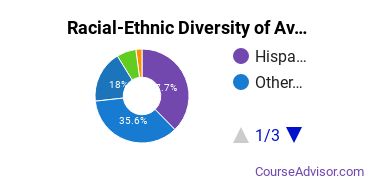Avalon School of Cosmetology - Phoenix Overview
Located in Phoenix, Arizona, Avalon School of Cosmetology - Phoenix is a private for-profit institution. Phoenix is a great location for students who prefer city over country life.
What Is Avalon School of Cosmetology - Phoenix Known For?
- The undergraduate certificate is the highest award offered at Avalon School of Cosmetology - Phoenix.
Where Is Avalon School of Cosmetology - Phoenix?

Contact details for Avalon School of Cosmetology - Phoenix are given below.
| Contact Details | |
|---|---|
| Address: | 410 E Bell Road, Suite G100, Phoenix, AZ 85022 |
| Phone: | 602-443-0076 |
| Website: | avalon.edu |
Can I Afford Avalon School of Cosmetology - Phoenix?
Student Loan Debt
It's not uncommon for college students to take out loans to pay for school. In fact, almost 66% of students nationwide depend at least partially on loans. At Avalon School of Cosmetology - Phoenix, approximately 65% of students took out student loans averaging $4,474 a year. That adds up to $17,896 over four years for those students.
Explore Best Ranked Schools for You
Avalon School of Cosmetology - Phoenix Undergraduate Student Diversity

Gender Diversity
Of the 249 full-time undergraduates at Avalon School of Cosmetology - Phoenix, 3% are male and 97% are female.

Racial-Ethnic Diversity
The racial-ethnic breakdown of Avalon School of Cosmetology - Phoenix students is as follows.

| Race/Ethnicity | Number of Grads |
|---|---|
| Asian | 2 |
| Black or African American | 16 |
| Hispanic or Latino | 94 |
| White | 97 |
| International Students | 0 |
| Other Races/Ethnicities | 40 |
Avalon School of Cosmetology - Phoenix Undergraduate Concentrations
The table below shows the number of awards for each concentration.
| Major | Basic Certificate | Undergraduate Certificate | TOTAL |
|---|---|---|---|
| Cosmetology | 280 | 129 | 409 |
| Somatic Bodywork & Therapeutic Services | 0 | 0 | 0 |
| TOTAL | 280 | 129 | 409 |
References
*The racial-ethnic minorities count is calculated by taking the total number of students and subtracting white students, international students, and students whose race/ethnicity was unknown. This number is then divided by the total number of students at the school to obtain the racial-ethnic minorities percentage.
More about our data sources and methodologies.
